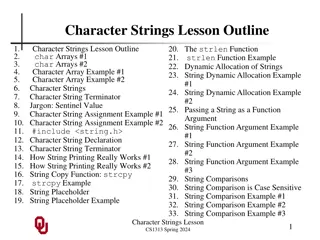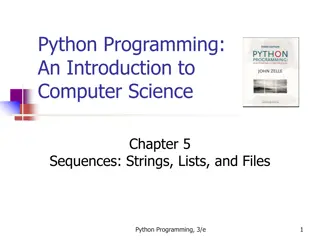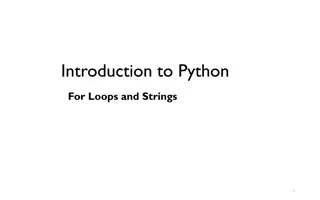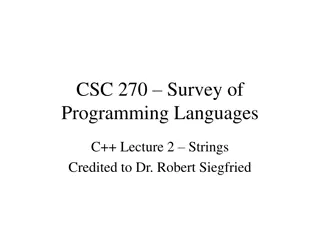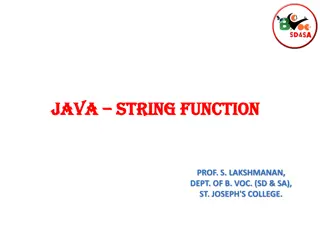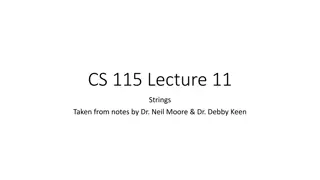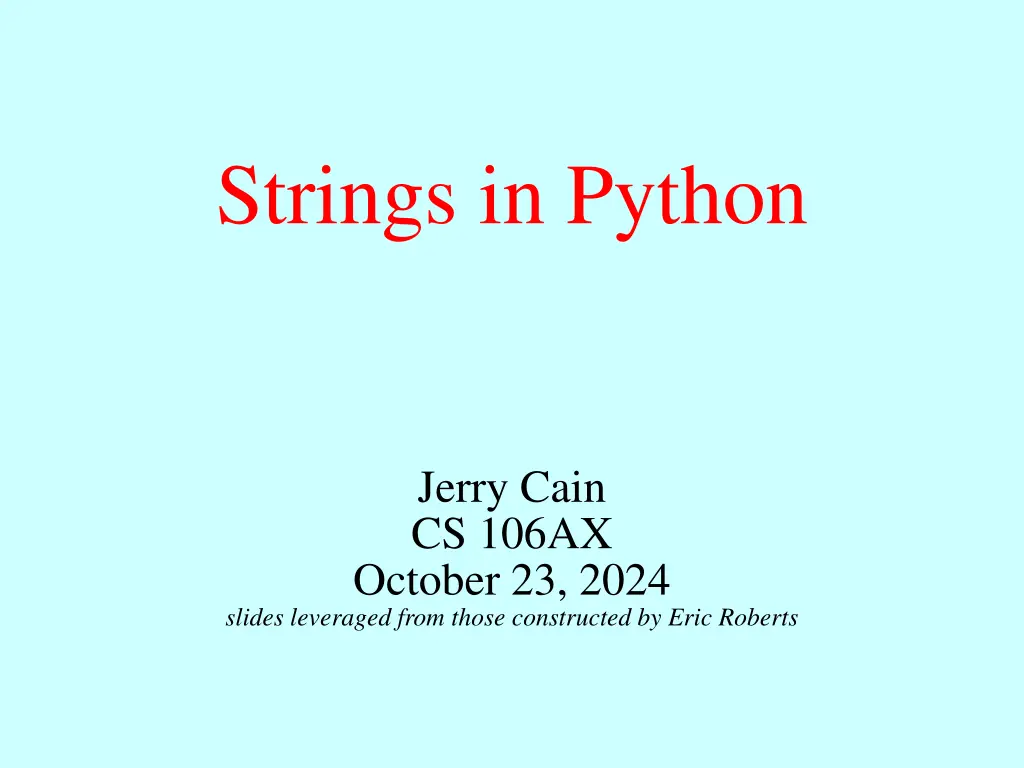
Understanding Strings in Python
Learn how to work with strings in Python, including selecting characters, negative indexing, concatenation, repetition, and exercise examples. Get insights into the fundamentals of manipulating text data efficiently in Python programming.
Uploaded on | 1 Views
Download Presentation

Please find below an Image/Link to download the presentation.
The content on the website is provided AS IS for your information and personal use only. It may not be sold, licensed, or shared on other websites without obtaining consent from the author. If you encounter any issues during the download, it is possible that the publisher has removed the file from their server.
You are allowed to download the files provided on this website for personal or commercial use, subject to the condition that they are used lawfully. All files are the property of their respective owners.
The content on the website is provided AS IS for your information and personal use only. It may not be sold, licensed, or shared on other websites without obtaining consent from the author.
E N D
Presentation Transcript
Strings in Python Jerry Cain CS 106AX October 23, 2024 slides leveraged from those constructed by Eric Roberts
Selecting Characters from a String A string is (still) an ordered collection of characters. The character positions in a Python string are, as in most computer languages, identified by an index beginning at 0. For example, if s is initialized as s = "hello, world" the characters ins are arranged like this: h e l l o , w o r l d 0 1 2 3 4 5 6 7 8 9 10 11 You can select an individual character using the syntax str[k], where k is the index of the desired character. The expression s[7] returns the one-character string "w" that appears at index 7.
Negative Indexing Unlike JavaScript, Python allows you to specify a character position in a string by using negative index numbers, which count backwards from the end of the string. The characters in the "hello,world" string on the previous slide can therefore be numbered using the following indices: h e l l o , w o r l d 12 11 10 9 8 7 6 5 4 3 2 1 You can select the "w" toward the end of this string using the expression s[-5] which is shorthand for the positive indexing expression s[len(s)-5]
Concatenation One of the more familiar operations available to Python strings is concatenation, which consists of combining two strings end to end with no intervening characters. Concatenation is built into Python in the form of the + operator. This is consistent with how JavaScript and most other languages support concatenation. Noteworthy difference between Python and JavaScript: Python interprets the + operator as concatenation only if both operands are strings. If one of the operands is something other than a string, then string concatenation isn t applied. Restated, Python doesn t automatically convert numbers to strings as JavaScript does.
Repetition In much the same way that Python redefines the + operator to indicate string concatenation, it also redefines the * operator for strings to indicate repetition, so that the expression s*n indicates n copies of the string s concatenated together. The expression "la"*3 therefore returns "lalala", which is three copies of the string "la" concatenated together. Note that this interpretation is consistent with the idea that multiplication is repeated addition: "la" * 3 "la" + "la" + "la" You can use this feature, for example, to print a line of 80 hyphens like this: print("-" * 80)
Exercise: String Repetition Use string repetition to encode the following songs in as short a Python program as possible: Let it be Let it be Let it be Let it be Whisper words of wisdom Let it be I can feel your halo halo halo I can see your halo halo halo I can feel your halo halo halo I can see your halo halo halo Paul McCartney, "Let it Be", 1970 Beyonc , "Halo", 2008 In 1984, computer Don Knuth published a paper on "The Complexity of Songs" in which he concludes that Casey and the Sunshine Band holds the record for longest song lyric. u = " uh huh"*2 s =("That's the way"+u+"I like it"+u+"\n")*
Exercise: removeDoubledLetters In the early part of the 20th century, there was considerable interest in both England and the United States in simplifying the rules used for spelling English words, which has always been a difficult proposition. One suggestion advanced as part of this movement was to eliminate all doubled letters, so that bookkeeper would be written as bokeper and committee would become comite. Write a function removeDoubledLetters(s) that returns a new string in which any neighboring duplicated characters in s have been replaced by a single copy.
Slicing Python allows you to extract a substring by specifying a range of index positions inside the square brackets. This operation is known as slicing. The simplest specification of a slice is [start:stop], where start is the index at which the slice begins, and stop is the past-the- end index where the slice ends. The start and stop components of a slice are optional, but the colon must be present. If start is missing, it defaults to 0, and if stop is missing, it defaults to the length of the string. A slice specification may also contain a third component called a stride, as with [start:stop:stride]. Strides indicate how many positions are omitted between selected characters. The stride component can be negative, in which case the selection occurs backwards from the end of the string.
Exercise: Slicing Suppose that you have initialized ALPHABET as ALPHABET = "ABCDEFGHIJKLMNOPQRSTUVWXYZ" so that the index numbers (in both directions) run like this: A B C D E F G H I J K L M N O P Q R S T U V W X Y Z 0 1 2 3 4 5 6 7 8 9 10 11 12 13 14 15 16 17 18 19 20 21 22 23 24 25 24 23 22 21 20 19 18 17 16 15 14 13 What are the values of the following slice expressions? 26 25 12 11 10 9 8 7 6 5 4 3 2 1 (a) ALPHABET[7:9] (f) ALPHABET[1:-1] (b) ALPHABET[-3:-1] (g) ALPHABET[0:5:2] (c) ALPHABET[:3] (h) ALPHABET[::-1] (d) ALPHABET[-1:] (i) ALPHABET[5:2:-1] (e) ALPHABET[14:-12] (j) ALPHABET[14:2:-3]
Methods for Finding Patterns str.find(pattern) Returns the first index of pattern in str, or 1 if it does not appear. str.find(pattern, k) Same as the one-argument version but starts searching from index k. str.rfind(pattern) Returns the last index of pattern in str, or 1 if it does not appear. str.rfind(pattern, k) Same as the one-argument version but searches backward from index k. str.startswith(prefix) Returns True if this string starts with prefix. str.endswith(suffix) Returns True if this string ends with suffix.
Methods for Transforming Strings str.lower() Returns a copy of str with all letters converted to lowercase. str.upper() Returns a copy of str with all letters converted to uppercase. str.capitalize() Capitalizes the first character in str and converts the rest to lowercase. str.strip() Removes whitespace characters from both ends of str. str.replace(old, new) Returns a copy of str with all instances of old replaced by new.
Methods for Classifying Characters ch.isalpha() Returns True if ch is a letter. ch.isdigit() Returns True if ch is a digit. ch.isalnum() Returns True if ch is a letter or a digit. ch.islower() Returns True if ch is a lowercase letter. ch.isupper() Returns True if ch is an uppercase letter. ch.isspace() Returns True if ch is a whitespace character (space, tab, or newline). str.isidentifier() Returns True if this string is a legal Python identifier.
Revisiting Pig Latin in Python "isthay" "isway" "igpay" "atinlay" result word word word word "latin" "isthay isway igpay atinlay" vp vp vp vp head head head head tail tail tail tail start word "p" "l" ch i ch line i "this" "is" "pig" "isthay isway igpay" "isthay isway igpay " 2 0 1 1 "th" "is" "ig" "atin" "this" 0 "t" 1 2 "this is pig latin" "isthay" "isthay " "isthay isway" "isthay isway " "" -1 0 -1 5 -1 8 -1 12 0 1 2 3 4 5 6 7 8 9 10 11 12 13 14 15 16 17 "t" "h" "i" "s" " " "i" "s" " " "p" "i" "g" " " "l" "a" "t" "i" "n" >>> toPigLatin("this is pig latin") isthay isway igpay atinlay
Exercise: Implement translate Pig Latin is just one example of a language game designed to render spoken words to be incomprehensible to the untrained ear. B-Language is another such language game known primarily in Germany where words are transformed such that every vowel cluster is reduplicated with a leading "b". Implement of translate, which accepts a lowercase (English) word and returns its B-Language translation. Examples: translate("quick") translate("spaghetti") translate("adieu") translate("audiophile") translate("queueing") "quibuick" "spabaghebettibi" "abadieubieu" "aubaudiobiophibilebe" "queueibueueing"
Exercise: Implement translate def translate(word, sep='b'): """ Accepts the provided word, assumed to be comprised of lowercase letters, and returns its B-Language translation. An optional second argument can be supplied to override the 'b' with any other string. """ start = -1 translation = '' for i in range(len(word)): ch = word[i] if isEnglishVowel(ch): if start == -1: start = i else: if start >= 0: translation += word[start:i] + sep + word[start:i] start = -1 translation += ch if start >= 0: translation += word[start:] + sep + word[start:] return translation
Exercise: Implement extract Uniform Resource Locators, or URLs, are string expressions used to identify where documents can be found on the Internet. Many URLs include query strings, which are substrings appearing after a "?" that further refine what portion of a document should be retrieved. For example: https://www.google.edu/search?q=hello&tbm=vid lists public videos associated with "hello" , which unsurprisingly includes a whole lot of Adele.
Exercise: Implement extract Query strings are really just string serializations of maps in the sense you learned about JavaScript aggregates, where keys are separated from values by equal signs, and key-value pairs are separated from one another by ampersands. Implement extract, which lists all key value pairs, one per line, embedded within the query string of a URL. For example: extract("https://explorecourses.stanford.edu/search?view=catalog&"\ "academicYear=&page=0&q=CS&filter-departmentcode-CS=on&"\ "filter-coursestatus-Active=on&filter-term-Winter=on") would print the following in the Terminal Key: "view", Value: "catalog" Key: "academicYear", Value: "" Key: "page", Value: "0" Key: "q", Value: "CS" Key: "filter-departmentcode-CS", Value: "on" Key: "filter-coursestatus-Active", Value: "on" Key: "filter-term-Winter", Value: "on"
Exercise: Implement extract def extract(url): """ Parses the supplied URL and prints out all of the key value pairs, one per line. """ qmpos = url.find('?') if qmpos == -1: return query = url[qmpos + 1:] hpos = query.find('#') if hpos != -1: query = query[:hpos] start = 0 while start < len(query): epos = query.find('=', start) key = query[start:epos] apos = query.find('&', epos + 1) if apos == -1: apos = len(query) value = query[epos + 1: apos] print('Key: \"{}\", Value: \"{}\"'.format(key, value)) start = apos + 1






